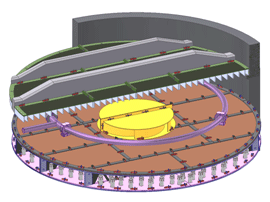Reactor Internals
ISOMIX-e
Introduced in 2011, ISOMIX-e®, CLG’s latest reactor internals design, offers the following benefits:
The new advanced design has many distinguishing features that result in excellent radial temperature distribution in the reactor with mitigation of hot spots, and in maximum utilization of the installed catalyst. Design innovations also enable easier installation and reduced maintenance time during turnarounds. These design innovations also allow for easier retrofits.
Its compact size occupies less reactor space and provides additional reactor volume for active catalyst, both in grassroots as well as retrofit applications.

Shown here, the new design uses an improved structure that utilizes a truss system to support the internals components below the catalyst support tray. In addition, the beams holding up the catalyst support grid panels is turned upward to increase the catalyst volume per reactor length by decreasing the height required for the internals. The truss system will avoid the hangers connecting catalyst beams to the trays below and now allow us to utilize wedge pin closures to hold individual panels together throughout the internals, rather than relying on single, immovable trays.
- Easy to assemble and disassemble for faster installation, turnarounds and retrofits through use of wedge pin closures
- Easy to clean and to replace panels with easy access to all parts of the internals
- Efficient use of space with up to 10-12” less height required per set of inter-bed internals, resulting in more volume for active catalysts
- Elegant use of novel liquid entry design for flow nozzles that results in little to no disturbance on the catalyst bed below, allowing removal of the hold down layer used in other designs
- Effective at collecting, mixing and redistributing the reactants resulting in small radial temperature spreads
- Eliminates quench pipe protrusion through catalyst support grids
- Efficient use of less expensive or more available materials, and fabrication methods for cost savings
The new advanced design has many distinguishing features that result in excellent radial temperature distribution in the reactor with mitigation of hot spots, and in maximum utilization of the installed catalyst. Design innovations also enable easier installation and reduced maintenance time during turnarounds. These design innovations also allow for easier retrofits.
Its compact size occupies less reactor space and provides additional reactor volume for active catalyst, both in grassroots as well as retrofit applications.

Shown here, the new design uses an improved structure that utilizes a truss system to support the internals components below the catalyst support tray. In addition, the beams holding up the catalyst support grid panels is turned upward to increase the catalyst volume per reactor length by decreasing the height required for the internals. The truss system will avoid the hangers connecting catalyst beams to the trays below and now allow us to utilize wedge pin closures to hold individual panels together throughout the internals, rather than relying on single, immovable trays.